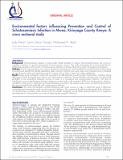| dc.contributor.author | Mwai, Judy | |
| dc.contributor.author | Omogi, Jarim Oduor | |
| dc.contributor.author | Abdia, Mohamed H. | |
| dc.date.accessioned | 2022-02-05T15:03:27Z | |
| dc.date.available | 2022-02-05T15:03:27Z | |
| dc.date.issued | 2021-06-11 | |
| dc.identifier.citation | Mwai J, Omogi OJ, Abdi MH. Environmental factors influencing Prevention and Control of Schistosomiasis Infection in Mwea, Kirinyaga County Kenya: A cross sectional study. East Afr Health Res J. 2021;5(1):99-105. https://doi. org/10.24248/eahrj.v5i1.657 | en_US |
| dc.identifier.uri | https://repository.amref.ac.ke/handle/123456789/582 | |
| dc.description | © Mwai et al. This is an open-access article distributed under
the terms of the Creative Commons Attribution License, which
permits unrestricted use, distribution, and reproduction in any
medium, provided the original author and source are properly
cited. To view a copy of the license, visit http://creativecommons.
org/licenses/by/4.0/. When linking to this article, please use
the following permanent link: https://doi.org/10.24248/eahrj.
v5i1.657 | en_US |
| dc.description.abstract | Background: Schistosomiasis remains a major public health problem in Kenya. Environmental factors are critical in
creating a medium for growth and spread of schistosomiasis vectors. The study investigated the environmental factors
influencing prevention and control of schistosomiasis infection in Mwea West Sub County, Kirinyaga County-Kenya.
Methods: A multi stage sampling was used to identify four hundred and sixty-five (465) household. Analytical descriptive
cross-sectional design that utilised quantitative data collection method was used. Data was collected using a pretested
structured questionnaire and analysed using Chi square tests or Fisher’s exact tests where applicable.
Results: Study results indicated a significant association p<.001 between household level of education, members being
affected by floods during the rainy season and schistosomiasis infection. The result further indicates level of significance
(p<0.047) in the association between sources of water in a household and schistosomiasis infection. No level of
significance was posted between having a temporary water body in the area p (=.072) and schistosomiasis infection.
In addition, there was no significant association between proximity to the nearest water source, p=.074 and proximity to
the nearest health facility p=0.356 with schistosomiasis infection.
Conclusions: The study recommends carefully designing safe water sources in order to match the goal of effectively
controlling and reversing the trends of schistosomiasis infections. The community should be made aware of the risk factors
of schistosomiasis including water utilised in the household’s alongside raising health seeking behaviours for diagnosis
and treatment of schistosomiasis as a way of reducing the spread of infection. | en_US |
| dc.description.sponsorship | Kenya Medical Research Institute (KEMRI) | en_US |
| dc.language.iso | en | en_US |
| dc.publisher | The East African Health Research Commission | en_US |
| dc.subject | Environmental factors | en_US |
| dc.subject | Floods | en_US |
| dc.subject | Water | en_US |
| dc.subject | Households | en_US |
| dc.subject | Agricultural area | en_US |
| dc.subject | Schistosomiasis | en_US |
| dc.title | Environmental Factors Influencing Prevention and Control of Schistosomiasis Infection in Mwea, Kirinyaga County Kenya: A Cross Sectional Study (nih.gov) | en_US |
| dc.type | Article, Journal | en_US |

